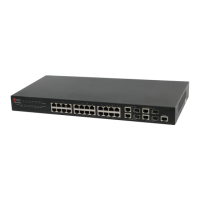+7(495) 797-3311 www.qtech.ru
Москва, Новозаводская ул., 18, стр. 1
Chapter 61 Debugging and Diagnosis for
Packets Received and Sent by CPU
61.1 Introduction to Debugging
and Diagnosis for Packets
Received and Sent by CPU
The following commands are used to debug and diagnose the packets received and sent by
CPU, and are supposed to be used with the help of the technical support.
61.2 Debugging and Diagnosis for
Packets Received and Sent by CPU
Task List
cpu-rx-ratelimit protocol <protocol-type>
<packets>
no cpu-rx-ratelimit protocol [ <protocol- type> ]
Set the max rate of the CPU
receiving packets of the protocol
type, the no command set the max
rate to default.
clear cpu-rx-stat protocol [ <protocol-type> ]
Clear the statistics of the CPU
received packets of the protocol type.
show cpu-rx protocol [ <protocol-type> ]
Show the information of the CPU
received packets of the protocol type.
debug driver {receive|send} [interface {<interface-
name> |all}] [protocol {<protocol-type> |discard
|all}][detail]
Turn on the showing of the CPU
receiving or sending packet
informations.
no debug driver {receive |send}
Turn off the showing of the CPU
receiving or sending packet
informations.

